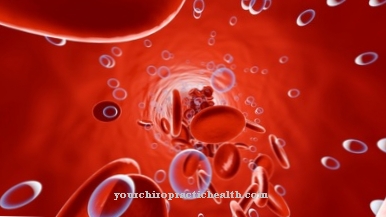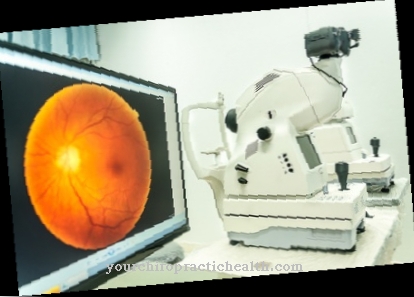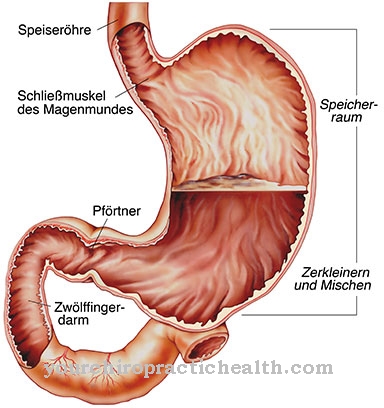Anti-epileptic drugs - also as Anticonvulsants known - are drugs that are used to treat epilepsy (seizures). Furthermore, they are used prophylactically as a migraine therapy as well as in the field of pain therapy. The first anti-epileptic drugs were tested back in 1912.
What are anti-epileptic drugs?

Anti-epileptic drugs are chemical-pharmaceutical drugs that are primarily used to treat epileptic diseases. Depending on which pharmacological active ingredient group the anti-epileptic belongs to, the drug is also used for other diseases. Other areas of application include a. neuralgic pain, fibromyalgia, neuropathy, paresthesia.
In the case of anticonvulsants - as antiepileptics are also called - a distinction is made between classic products and so-called new antiepileptics. Not every drug in these drug groups is suitable for all types of seizures. Depending on which brain regions are affected by an epileptic seizure and whether it is a focal or a generalized (affecting the entire brain) seizure, different antiepileptic drugs are prescribed.
Antiepileptic drugs are primarily used to reduce the transmission of stimuli as well as the neuronal excitability of the central nervous system.
Application, effect & use
Anti-epileptic drugs are primarily used to treat epileptic seizures. Epilepsy is caused by an overactive electrical nerve activity in the brain. The brain function is severely restricted by overloading the nerve tracts. With every epileptic seizure, the brain is permanently damaged. Because of this, epilepsy must be treated or constantly treated prophylactically with anti-epileptic drugs.
However, anti-epileptic drugs are not only used in epilepsy. They serve as prophylaxis during operations on the brain, spinal cord and spine to prevent seizures during the surgical procedure. In recent years in particular, anti-epileptic drugs have also been discovered for pain therapy. Together with selected painkillers, neuralgic pain can be successfully treated. Other areas of application of anti-epileptic drugs are alcohol and drug withdrawal and anesthesia.
Antiepileptic drugs act directly on the nervous system and nerve cells. They ensure that the transmission of stimuli by the nerves is inhibited and the excitability of the nerve cells in the brain is reduced. Antiepileptic drugs have three mechanisms of action. They influence the neurotransmitters (messenger substances of the nervous system). The most important seizure-inhibiting neurotransmitter is gamma-amino-butyric acid (GABA). So-called benzodiazepines and barbiturates are used to increase the effect and the duration of the action of the brain's own messenger substance GABA.
Antiepileptic drugs also have an effect on sodium and calcium, which increase the transmission of stimuli to the nerves. With the help of anti-epileptic drugs, the absorption of minerals is reduced, so that the transmission of stimuli and the excitability of the nerve cells are reduced or blocked. Another mechanism of action of anti-epileptic drugs is the inhibition of various enzymes in the brain that increase the conduction of stimuli and the excitability of the nerve cells.
Herbal, natural & pharmaceutical anti-epileptic drugs
Anti-epileptic drugs belong to the group of heterogeneous drugs. The anti-epileptics are divided into barbiturates, benzodiazepines, suximides, carboxamides and the new anti-epileptics.
Barbiturates such as B. Phenobarbital and Primodon are used for long-term treatment of epilepsy. The dosage form is in the form of tablets.
Benzodiazepines such as B. Diazepam, Lorazepam, Chlordiazepoxid and Triazolam are also intended for the long-term treatment of epileptic seizures. The dosage forms are tablets, capsules, injection and drop solutions.
However, barbiturates and benzodiazepines are not classic anti-epileptic drugs. Its actual areas of application include the treatment of depression, psychosomatic complaints, pain and anxiety disorders. However, it has been shown that these drug groups are also successful in the treatment of epilepsy.
Suximides such as phenytoin are hydantoin derivatives that are used for the long-term treatment of epilepsy. Phenytoin has a broad mechanism of action and is suitable for mild forms of epilepsy as well as for grand mal seizures and the so-called status epilepticus. Phenytoin is available as tablets and as injection solutions for acute treatment.
Carboxamides such as carbamazepine and oxcarbazepine are used both to treat epilepsy and in pain therapy. The dosage forms are tablets, retard tablets and injection solutions.
First choice agents for long-term therapy are carbamazepine, valproate, diazepam, and lorazepam. In the event of intolerance or interactions with other drugs, i. d. R. Phenobarbital, ethosximide and phanytoin are used.
The so-called new anti-epileptic drugs gabapentin, lamotrigine, tiagabine, topiramate and vigabatrin are used as additional therapeutic agents in conjunction with other anti-epileptic drugs.
Risks & side effects
Lots Anti-epileptic drugs have a sedative effect, especially the group of benzodiazepines and barbiturates. Because of this, particular care should be taken when driving vehicles or operating machines.
Antiepileptic drugs should not be used during pregnancy as they have been shown to damage the embryo. Because of this, care should be taken to ensure that pregnancy does not occur. As anti-epileptic drugs reduce the effectiveness of hormonal contraceptives (pill, three-month injection, Implanon), additional methods of contraception such as condoms should be used to avoid pregnancy.
Antiepileptic drugs have a particularly intense effect on the heart and its function. If heart disease, liver dysfunction or kidney disease are present, antiepileptic drugs must not be taken. Other side effects include weight gain or loss, skin rash, itching, unsteady gait, incoordination, insomnia, speech disorders, involuntary movements, inflammation of the gums, nausea, vomiting, and connective tissue disorders.
Since there are frequent interactions with other drugs, the doctor and pharmacist should be asked if other drugs - including homeopathic ones - are taken. The use of anti-epileptic drugs requires regular blood tests.
Drug interactions
Anti-epileptic drugs can accelerate the breakdown of other drugs. This affects: birth control pills, antidepressants, valproic acid, cyclosporine, neuroleptics.
The following drugs inhibit the breakdown of antiepileptic drugs, so that overdosing or poisoning can occur: Antibiotics such as B. Erythromycin and troleandromycin, loratadine, protease inhibitors (HIV treatment), viloxazine, verapamil, etc.
Antiepileptic drugs must not be taken together with grapefruit juice, as its ingredients inhibit the breakdown of antiepileptic drugs. Herbal medicines such as St. John's wort must also not be taken with anti-epileptic drugs, as they also severely impair the effectiveness of the drug.
Vitamins and minerals such as B. Calcium and magnesium can make anti-epileptic drugs less effective. The anti-epileptic carbamazepine must not be taken together with the anti-epileptic phenytoin, as they limit each other's effectiveness.




.jpg)








.jpg)


.jpg)





.jpg)





